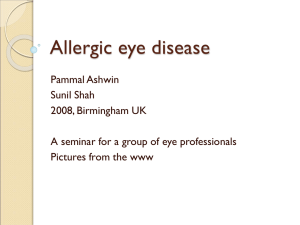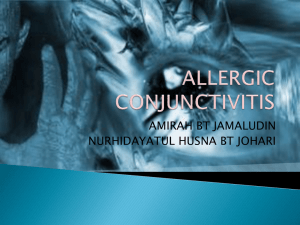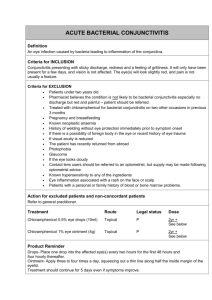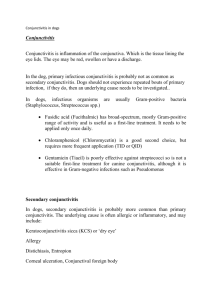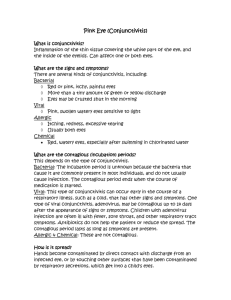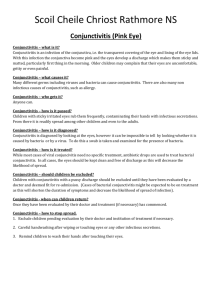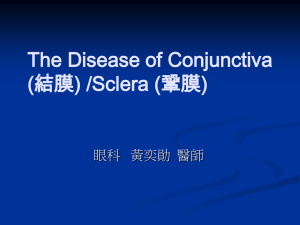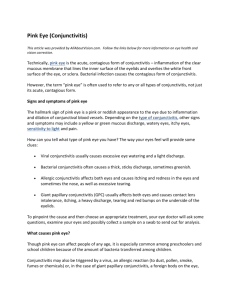allergic_conjunctivitis
advertisement
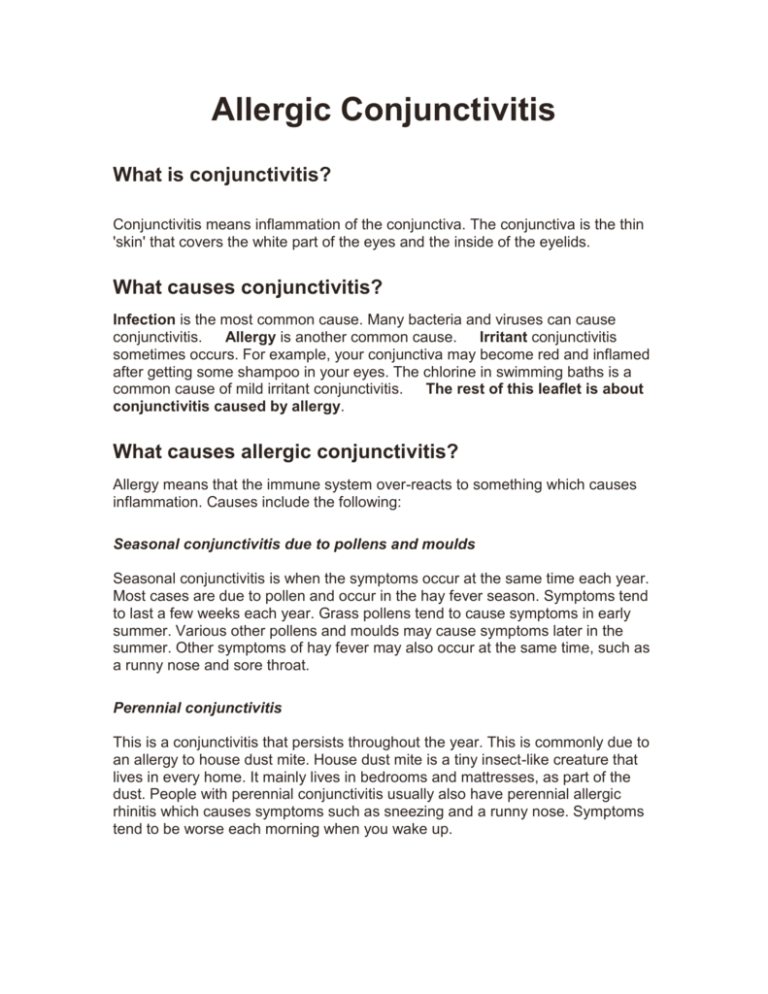
Allergic Conjunctivitis What is conjunctivitis? Conjunctivitis means inflammation of the conjunctiva. The conjunctiva is the thin 'skin' that covers the white part of the eyes and the inside of the eyelids. What causes conjunctivitis? Infection is the most common cause. Many bacteria and viruses can cause conjunctivitis. Allergy is another common cause. Irritant conjunctivitis sometimes occurs. For example, your conjunctiva may become red and inflamed after getting some shampoo in your eyes. The chlorine in swimming baths is a common cause of mild irritant conjunctivitis. The rest of this leaflet is about conjunctivitis caused by allergy. What causes allergic conjunctivitis? Allergy means that the immune system over-reacts to something which causes inflammation. Causes include the following: Seasonal conjunctivitis due to pollens and moulds Seasonal conjunctivitis is when the symptoms occur at the same time each year. Most cases are due to pollen and occur in the hay fever season. Symptoms tend to last a few weeks each year. Grass pollens tend to cause symptoms in early summer. Various other pollens and moulds may cause symptoms later in the summer. Other symptoms of hay fever may also occur at the same time, such as a runny nose and sore throat. Perennial conjunctivitis This is a conjunctivitis that persists throughout the year. This is commonly due to an allergy to house dust mite. House dust mite is a tiny insect-like creature that lives in every home. It mainly lives in bedrooms and mattresses, as part of the dust. People with perennial conjunctivitis usually also have perennial allergic rhinitis which causes symptoms such as sneezing and a runny nose. Symptoms tend to be worse each morning when you wake up. Allergies to animals Coming into contact with some animals can cause a bout of allergic conjunctivitis. Giant papillary conjunctivitis This is uncommon. It is inflammation of the conjunctiva lining the upper eyelid. It occurs in some people who have a small object on the eye - most commonly, a contact lens. It affects about 1 in 100 wearers of contact lenses. The exact cause of the inflammation is unclear - it is possibly an allergic reaction to debris caught behind a lens or to poor lens hygiene. It also sometimes develops after eye surgery. Contact conjunctivitis Some people become sensitised to cosmetics, make-up, eye drops or other chemicals that come into contact with the conjunctiva. This then causes an allergic response and symptoms of conjunctivitis. In this condition the skin on the eyelids may also become inflamed. It is then called contact dermatoconjunctivitis. What are the symptoms of allergic conjunctivitis? Both eyes are usually affected and symptoms tend to develop quickly. The eyes are usually itchy, and the whites of the eyes look red or pink. A burning feeling may occur, but the eyes are not usually painful. The eyelids tend to swell. The eyes water more than usual, but do not become too gluey as in infective conjunctivitis. Vision is not affected. In severe cases the conjunctiva under the upper eyelids may swell and look lumpy. Are there any possible complications? Seasonal and perennial conjunctivitis can be unpleasant, but complications are rare. Contact dermatoconjunctivitis and giant papillary conjunctivitis occasionally cause inflammation and ulceration of the cornea (keratitis), which may cause some permanent loss of vision if left untreated. What is the treatment for allergic conjunctivitis? If you use contact lenses: in general, do not wear lenses until symptoms have gone, and for 24 hours after the last dose of any eye drop or ointment. However, your doctor or optometrist will advise if you can wear lenses with certain types of drops. Try not to rub your eyes as this can cause more inflammation. Bathing the eyes with a flannel soaked in cold water may ease symptoms. Avoid the cause of the allergy, if possible. For example, if you have seasonal conjunctivitis, then during the hay fever season try staying indoors as much as possible, closing windows, wearing wrap-around sunglasses when out, etc. Treatment for seasonal, perennial and animal-related conjunctivitis In addition to the general measures described above: No other treatment may be needed if symptoms are mild. Eye drops that reduce the allergic reaction are often prescribed. Two main classes of eye drops are used - antihistamine eye drops and mast cell stabiliser eye drops. (Mast cells and histamine are both involved in the allergic reaction. The eye drops counter the actions of histamine or mast cell destabilisation which results in histamine release.) There are various types and brands in each class of eye drops. The eye drops usually work well. You need to use the drops regularly to keep symptoms away until the cause of the allergy goes. Some people find one product works better than another. Therefore, if the first does not work so well, a switch to another may help. If your eyelids are very swollen, it may take several days for the drops to ease symptoms fully. Antihistamine tablets. You can take these to ease the general symptoms of hay fever. They may ease eye symptoms but they tend not to work as well as eye drops to ease the eye symptoms. Side-effects (mainly drowsiness) are a problem for some people who take antihistamine tablets. Steroid eye drops are rarely needed or used. Steroids are good at reducing inflammation. However, they should only be used if other treatments fail. They are normally only used under the supervision of an eye specialist, as infection and other causes of conjunctivitis need to be definitely ruled out. (Steroids can make some other eye conditions worse.) Steroid tablets are occasionally used for 3-5 days when symptoms are severe. They work well but regular or longer courses are not advised due to the problem of possible side-effects with long-term use. Note: tell your doctor or pharmacist if you are pregnant or breast-feeding, as some treatments (including some eye drops) may not be advised. Treatment for giant papillary conjunctivitis A problem with contact lenses is the main cause of this. Treatment is mainly to remove contact lenses until the symptoms clear. Improved lens hygiene or a change in lens type may be advised once the symptoms have settled. Antihistamine eye drops or mast cell stabiliser eye drops (described above) may also help to ease symptoms. Treatment for contact conjunctivitis Treatment is to avoid whatever caused the reaction. When caused by a cosmetic, you should let symptoms go completely before trying an alternative product. Some cases are caused by an allergy to a particular eye drop used for another eye disease. In this situation you may need a specialist's advice as to what alternative eye drops may be suitable for the condition.
